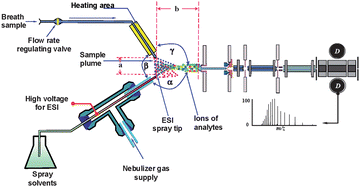In metabolomics studies and clinical diagnosis, interest is increasing in the rapid analysis of exhaled breath. In vivo breath analysis offers a unique, unobtrusive, non-invasive method of investigating human metabolism. To analyze breath in vivo, we constructed a novel platform of extractive electrospray ionization (EESI) ion trap mass spectrometry (ITMS) using a home-made EESI source coupled to a linear trap quadrupole mass spectrometer. A reference compound (authentic n-octyl amine) was used to evaluate effects of systematically varying selected characteristics of the EESI source on signal intensity. Under the optimized working conditions, metabolic changes of human bodies were in vivo followed by performing rapid breath analysis using the multi-stage EESI-ITMS tandem mass spectrometry platform. For nicotine, a limit of determination was found to be 0.05 fg mL−1 (S/N = 3, RSD = 5.0 %, n = 10) for nicotine in aerosol standard samples; the dynamic response range was from 0.0155 pg mL−1 to 155 pg mL−1. The concentration of nicotine in the exhaled breath of a regular smoker was in vivo determined to be 5.8 pg mL−1, without any sample pre-treatment. Our results show that EESI-ITMS is a powerful analytical platform to provide high sensitivity, high specificity and high throughput for semi-quantitative analysis of complex samples in life science, particularly for in vivo metabolomics studies.

You have access to this article
 Please wait while we load your content...
Something went wrong. Try again?
Please wait while we load your content...
Something went wrong. Try again?


 Please wait while we load your content...
Please wait while we load your content...